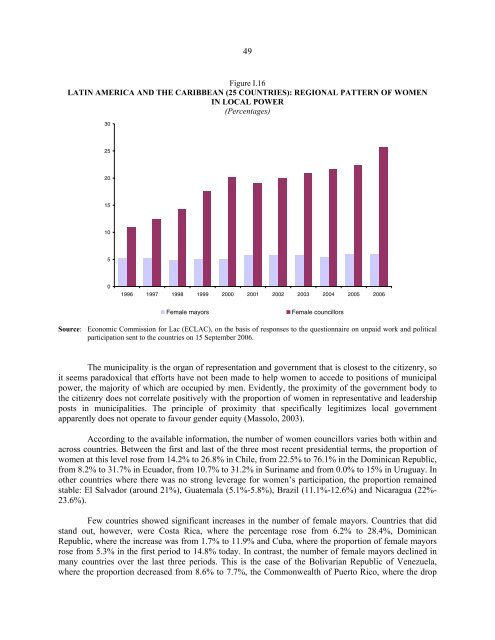Women in Latin America and the Caribbean - Cepal
Women in Latin America and the Caribbean - Cepal
Women in Latin America and the Caribbean - Cepal
Create successful ePaper yourself
Turn your PDF publications into a flip-book with our unique Google optimized e-Paper software.
49<br />
Figure I.16<br />
LATIN AMERICA AND THE CARIBBEAN (25 COUNTRIES): REGIONAL PATTERN OF WOMEN<br />
IN LOCAL POWER<br />
(Percentages)<br />
30<br />
25<br />
20<br />
15<br />
10<br />
5<br />
0<br />
1996 1997 1998 1999 2000 2001 2002 2003 2004 2005 2006<br />
Female mayors<br />
Female councillors<br />
Source: Economic Commission for Lac (ECLAC), on <strong>the</strong> basis of responses to <strong>the</strong> questionnaire on unpaid work <strong>and</strong> political<br />
participation sent to <strong>the</strong> countries on 15 September 2006.<br />
The municipality is <strong>the</strong> organ of representation <strong>and</strong> government that is closest to <strong>the</strong> citizenry, so<br />
it seems paradoxical that efforts have not been made to help women to accede to positions of municipal<br />
power, <strong>the</strong> majority of which are occupied by men. Evidently, <strong>the</strong> proximity of <strong>the</strong> government body to<br />
<strong>the</strong> citizenry does not correlate positively with <strong>the</strong> proportion of women <strong>in</strong> representative <strong>and</strong> leadership<br />
posts <strong>in</strong> municipalities. The pr<strong>in</strong>ciple of proximity that specifically legitimizes local government<br />
apparently does not operate to favour gender equity (Massolo, 2003).<br />
Accord<strong>in</strong>g to <strong>the</strong> available <strong>in</strong>formation, <strong>the</strong> number of women councillors varies both with<strong>in</strong> <strong>and</strong><br />
across countries. Between <strong>the</strong> first <strong>and</strong> last of <strong>the</strong> three most recent presidential terms, <strong>the</strong> proportion of<br />
women at this level rose from 14.2% to 26.8% <strong>in</strong> Chile, from 22.5% to 76.1% <strong>in</strong> <strong>the</strong> Dom<strong>in</strong>ican Republic,<br />
from 8.2% to 31.7% <strong>in</strong> Ecuador, from 10.7% to 31.2% <strong>in</strong> Sur<strong>in</strong>ame <strong>and</strong> from 0.0% to 15% <strong>in</strong> Uruguay. In<br />
o<strong>the</strong>r countries where <strong>the</strong>re was no strong leverage for women’s participation, <strong>the</strong> proportion rema<strong>in</strong>ed<br />
stable: El Salvador (around 21%), Guatemala (5.1%-5.8%), Brazil (11.1%-12.6%) <strong>and</strong> Nicaragua (22%-<br />
23.6%).<br />
Few countries showed significant <strong>in</strong>creases <strong>in</strong> <strong>the</strong> number of female mayors. Countries that did<br />
st<strong>and</strong> out, however, were Costa Rica, where <strong>the</strong> percentage rose from 6.2% to 28.4%, Dom<strong>in</strong>ican<br />
Republic, where <strong>the</strong> <strong>in</strong>crease was from 1.7% to 11.9% <strong>and</strong> Cuba, where <strong>the</strong> proportion of female mayors<br />
rose from 5.3% <strong>in</strong> <strong>the</strong> first period to 14.8% today. In contrast, <strong>the</strong> number of female mayors decl<strong>in</strong>ed <strong>in</strong><br />
many countries over <strong>the</strong> last three periods. This is <strong>the</strong> case of <strong>the</strong> Bolivarian Republic of Venezuela,<br />
where <strong>the</strong> proportion decreased from 8.6% to 7.7%, <strong>the</strong> Commonwealth of Puerto Rico, where <strong>the</strong> drop











